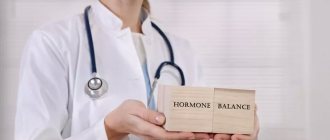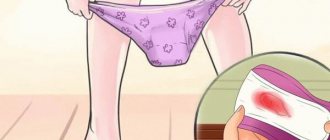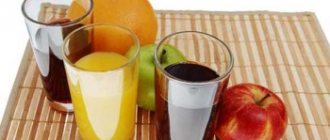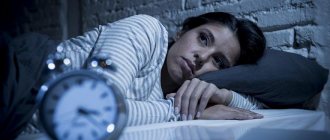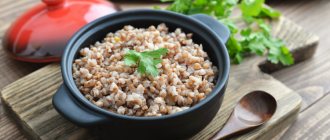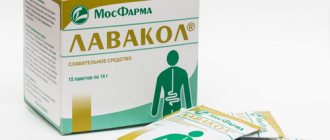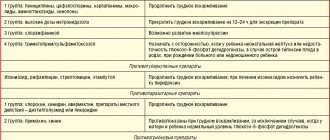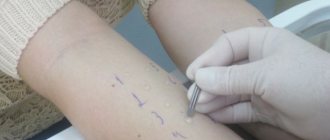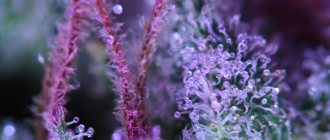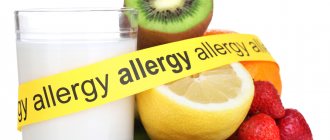Symptoms of hay fever
The development of hay fever usually occurs in two stages.
- Stage No. 1 – the first manifestations of the disease, which are transitory. The person will complain of severe itching in the throat, ears and nasal passages. Eye inflammation often occurs. Conjunctivitis, among other things, is accompanied by a fear of bright light, a feeling of sand in the eyes and lacrimation. After 5-8 hours from the moment of contact with the irritant substance, the second phase begins.
- Stage No. 2 – all allergic reactions intensify. High fever is possible. The eye compartments become purulent. In some individual cases, the breathing process may become very difficult. An allergy to pollen often manifests itself as hives. There is also a high probability of developing angioedema, inflammatory reactions of external organs, cystitis, allergic or contact dermatitis.
Another manifestation of hay fever can be “pollen intoxication”: frequent migraine attacks are replaced by a depressive state, irritability greatly increases and appetite decreases. If a person swallows pollen with honey, he may feel nausea and sharp pain in the abdomen1.
Question answer
Is it possible to walk with hay fever?
It is necessary for patients with hay fever to limit their stay in the fresh air (park, forest, field) at a strictly defined time - during the period of pollen dispersal by wind-pollinated plants. In other seasons there are no contraindications for walking.
Is it possible to get vaccinated for hay fever?
Preventive vaccinations are contraindicated during the season of exacerbation of hay fever - when the plant is flowering (dusting), which causes allergic reactions. Vaccination can be carried out during the interictal period, usually in late autumn or winter, after permission from an allergist.
Can you get a pet if you have hay fever?
In allergic pathologies, including hay fever, hypersensitivity often develops not to one type, but to many allergens - polyvalent allergy. Allergists do not advise having pets if you have hay fever, since the possibility of developing a cross-reaction cannot be ruled out.
Can there be a fever with hay fever?
With hay fever, the concentration of inflammatory mediators histamine and serotonin in the blood increases, which causes the development of “pollen” intoxication, which can increase body temperature to subfebrile levels of 37.5–38 degrees
Is it possible to eat citrus fruits with hay fever?
No you can not. Many products of plant origin (nuts, citrus fruits, peaches, cherries) have common antigens with pollen from plants that cause hay fever symptoms. Therefore, consuming citrus fruits even outside the flowering season can cause an exacerbation of the disease.
Hay fever in children
Allergies are especially pronounced during the flowering period: plants actively spread pollen, and children with a tendency to allergies react especially sharply. Symptoms may include:
- itching in the eye area;
- lacrimation and redness of the mucous membrane of the eye;
- severe cough and sneezing;
- runny nose in the form of clear, copious discharge;
- nasal congestion;
- attacks of suffocation.
Such symptoms indicate an exacerbation.
In addition, the flowering period of plants in children can cause redness, irritation and rashes on the surface of the skin. This reaction is given by the body upon contact with pollen grains2.
Table 1. Spring allergies – to tree blossoms
| March | April | May | June | July | August | September | October | |
| Trees | ||||||||
| Alder | ||||||||
| Birch | ||||||||
| Hazel | ||||||||
| Willow | ||||||||
| Willow | ||||||||
| Poplar | ||||||||
| Oak | ||||||||
| Elm | ||||||||
| Ash | ||||||||
| Maple | ||||||||
| Pine | ||||||||
| Spruce | ||||||||
| Linden | ||||||||
| Aspen | ||||||||
| period of detection of pollen in the air | ||||||||
| period of maximum pollen concentration in the air | ||||||||
An allergy to herbs manifests itself as a strong acute inflammatory process in the nasopharynx and is diagnosed by specialists as allergic rhinitis. Cough and conjunctivitis may also occur. In severe cases, an asthma attack develops.
To prevent the appearance of symptoms of hypersensitivity to pollen proteins from flowering plants and to mitigate the signs of the disease, there is an allergy sufferer’s calendar table, which contains all the necessary information (name of the plant, habitat, flowering periods).
Attention! When studying the table, you should pay attention to the following factors:
- Tree flowering period.
- The time when the first signs of allergy appear.
As a rule, the first symptoms appear in late March/early April. It usually lasts until June, until the flowering period ends.
Treatment of hay fever
The first thing to do when treating hay fever is to limit contact with the allergen plant.
- You should be outdoors as little as possible, especially in strong winds.
- At home, you need to install special filters to catch plant pollen.
- Remove certain foods from your diet that often lead to the appearance of these symptoms.
- For inflammation of the mucous membrane of the nose and throat, antihistamines should be used. For example, Cetrin®. blocks H1-histamine receptors. Prevents the development and facilitates the course of allergic reactions, has antipruritic and antiexudative effects. It has virtually no anticholinergic and antiserotonin effects. In therapeutic doses it practically does not cause a sedative effect. The onset of the effect after a single dose of 10 mg of cetirizine is 20 minutes, lasting more than 24 hours3.
- When the disease manifests itself in moderate severity, glucocorticosteroids are used (glucocorticoids are hormones formed in the adrenal cortex that affect protein and carbohydrate metabolism in the body). For bronchial asthma, a course of inhalations is prescribed.
- In case of severe disease, antihistamines are used in parallel with glucocorticosteroids.
To completely cure the disease, specific immunotherapy is performed. It involves the body receiving gradually increasing doses of a specific allergen. Upon completion of treatment, a significant decrease in sensitivity to the irritant substance will be observed.
When diagnosing the disease in children, provocative and contact tests are used. Doctors also prescribe serodiagnosis (PCR and ELISA).
As for contact skin tests, they are not carried out during the flowering phase. Preliminarily stop taking medications. When treating hay fever in children, it is important to restore the immune balance, and therefore emphasis should be placed on the comprehensive intake of restoratives4.
Diagnostics
Complaints, anamnesis, clinical picture, laboratory and instrumental examination methods (clinical blood test, blood for total Ig E, blood for eosinophilic cationic protein (blood chemistry), blood for specific Ig E to pollen allergens, nasal swab for eosinophils (rhinocytogram) , skin prick tests (or prick tests) with suspected non-infectious causally significant pollen allergens, spirometry (outcome + bronchodilator test)), consultation with an ENT doctor, ophthalmologist, allergist-immunologist, pulmonologist and others specialists if necessary.
Diet for hay fever
One of the effective methods of combating the symptoms of hay fever is a hypoallergenic diet. The principles of dietary nutrition are the same, but there are adjustments for the individual characteristics of the person and the type of hay fever. Experts recommend sticking to the prescribed diet from the end of March until May. This time period determines the flowering period of wormwood, ragweed and quinoa (from mid-July to early September).
To prevent hay fever, it is recommended to exclude from the daily diet:
- fruits and freshly squeezed juices;
- Birch juice;
- bee products (for example, honey);
- berries with seeds (cherries, apricots, cherries, etc.)
- alcoholic drinks;
- nuts and all food products containing this component;
- corn;
- carrots, paprika and celery;
- plant-based products (for example, infusions and herbal decoctions);
- legumes;
- products related to fermentation.
Particular care should be taken when eating foods such as tomatoes, onions, potatoes and cucumbers. You should also add homemade flour products to this list.
As for citrus fruits, they act as an allergen all year round, not only during the period of acute activity of hay fever.
In case of exacerbation of pollen allergy, it is recommended to reduce the consumption of easily digestible carbohydrates as much as possible. This group includes chocolate, sugar, confectionery and syrups.
Cheeses are on the list of prohibited foods. The most allergenic varieties are cheddar, Roquefort and Camembert. To ensure that the diet is as varied as possible, foods should be introduced gradually, in small doses. At the same time, observe the body’s reaction. When a food product is absorbed normally by the body, it is removed from the list of allergens.
To avoid the development of an allergic process in the form of swelling of the nasal mucosa, throat and the development of conjunctivitis, it is recommended to build a diet on the following products:
- butter;
- lean meats (rabbit, turkey, chicken);
- cereal porridge (buckwheat and rice);
- mineral water and dried fruit compotes;
- cottage cheese, yogurt, fermented baked milk and kefir5.
Allergen plant dusting calendar
There are quite a few plants that can cause an allergic reaction. Those that grow in the European part of Russia can be divided into three large groups - trees, cereals and weeds, and each group has its own flowering period.
| Flowering period | Plant species | |
| Trees | end of April – beginning of May | birch, beech, elm, oak, willow, maple, linden, hazel, poplar, ash |
| Cereals | end of May – beginning of July | rye, wheat, oats, barley, feather grass, bluegrass, fescue, chaff, wheatgrass, ryegrass, timothy, reed |
| Weeds | end of July – beginning of September | ragweed, nettle, quinoa, dandelion, plantain, wormwood, sorrel |
It should be taken into account that the timing of dusting may shift somewhat depending on the weather. But there are many sites on the Internet where you can always find out the current level of danger and get a forecast for the near future.
Prevention of hay fever
Preventive measures are relevant for people who do not have an allergic disease, but are at risk. And secondary measures apply to everyone suffering from allergies.
Primary methods of preventing hay fever:
- it is necessary to undergo regular examinations by an allergist, both children and adults;
- it is necessary to exclude or minimize contact with household chemicals;
- and the person should also be protected from the possible allergen (this especially applies to pregnant women).
Secondary methods of prevention:
- regularly carry out wet cleaning in the living space;
- do not use household chemicals;
- you should weigh the pros and cons when getting a cat or dog at home;
- it is necessary to minimize the consumption of fruits (especially citrus fruits), nuts, spices, and plant-based drinks (chicory, vermouths, balms)6.
It is important to understand that allergic hay fever, if left untreated for a long time, can lead to serious complications (for example, bronchial asthma - an allergic-type disease, characterized by a repeated attack of shortness of breath, which occurs when bronchial obstruction is impaired). If there is a possibility of developing an allergic disease, then it is necessary to take measures and not bring the situation to the hospital ward.
Bibliography
- Mikhailenko A. A. Allergy and allergic diseases / A. A. Mikhailenko, G. A. Bazanov. – M.: Medical Information Agency, 2009. – 304 p.
- Revyakina V. A. Features of hay fever in children in modern conditions / V. A. Revyakina // Attending physician. – 2012. – No. 4. – 12-15 s.
- Instructions for use of the medicinal product for medical use Cetrin®. – Registration number: P N013283/01.
- Allergology. Clinical recommendations developed by the RAACI Working Group / ed. R. M. Khaitova. – M.: Farmarus Print Media, 2013. – p. 126 p.
- Savelyeva Yu. Allergy. Treatment and prevention (electronic book) / Yu. Savelyeva. – M.: Scientific book publishing house, 2013
- Research Institute of Pediatrics: Diet for hay fever. – Access mode: https://www.kdcenter.ru – (Date of last access: 10/16/17).
Causes of allergies
Very often, allergies are hereditary. In this regard, all people can be divided into “allergy sufferers” and those not susceptible to allergens. This means that a healthy person, whose immune system works correctly, will not notice even strong allergens entering the body, while a person born with a malfunctioning immune system will experience the whole gamut of unpleasant sensations with minimal contact with allergens.
At the same time, allergies can develop at a certain point in life due to a malfunction of the immune system. Factors that can trigger the development of this condition are often: stress and treatment with antibiotics, a polluted environment and working with “chemicals,” smoking and poor diet, in general, any reasons that weaken the immune system in one way or another.
And if in the case of a hereditary predisposition there is no way to get rid of this disease, if the immune system is weakened and the allergic reaction that appears as a result, there is every chance to fight for your own health. It is only important to know and follow the recommendations of allergists.
Complications
If no measures are taken, hay fever progresses, adding new symptoms in adults. May develop:
- sinusitis,
- laryngitis,
- Quincke's edema;
- bronchial asthma;
- atopic dermatitis.
The patient experiences weakness, loses working capacity, becomes drowsy, and irritable. When consuming foods containing an allergen, gastritis often develops, then enteritis. Abdominal pain can be combined with skin rashes such as hives and itching of the anus.
Quincke's edema requires emergency medical attention. At the first sign, you need to call an ambulance.
Table 2. Summer allergies – to pollen
| March | April | May | June | July | August | September | October | |
| Herbs and grains | ||||||||
| Dandelion | ||||||||
| Wheatgrass | ||||||||
| Chenopodiaceae | ||||||||
| Sagebrush | ||||||||
| Plantain | ||||||||
| Nettle | ||||||||
| Sorrel | ||||||||
| Sunflower | ||||||||
| Timofeevka | ||||||||
| Ryegrass | ||||||||
| Fescue | ||||||||
| Quinoa | ||||||||
| Ambrosia | ||||||||
| period of detection of pollen in the air | ||||||||
| period of maximum pollen concentration in the air | ||||||||
Summer allergic reactions are identical in symptoms to spring allergies. It can be either an independent disease, or a continuation of the body’s reaction to pollen from flowering trees, or its relapse (the reappearance of signs of the disease after its cessation).
Important! To determine the diagnosis (independent disease or relapse), it is necessary to determine when and to which plant a negative reaction appeared. Adequate examination and identification of the type of allergen is necessary. The developed grain/herb/flower allergy table will help people suffering from this disease.
